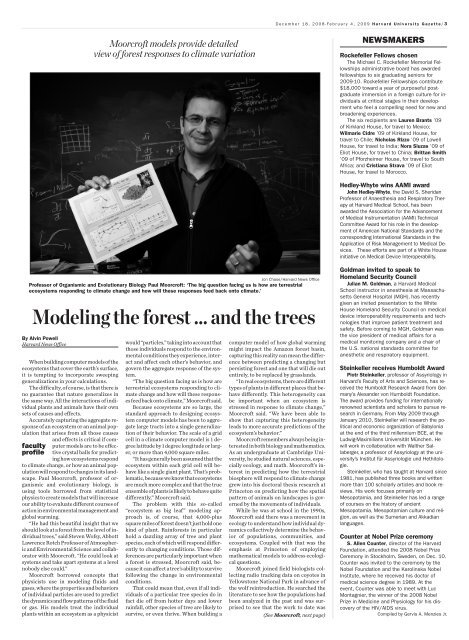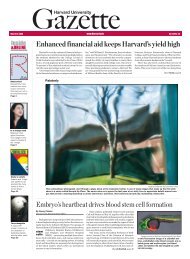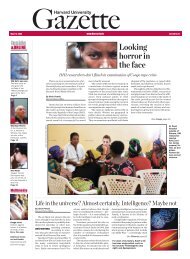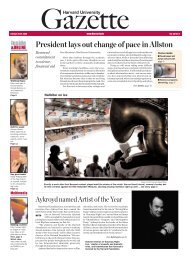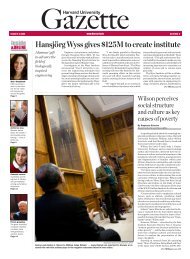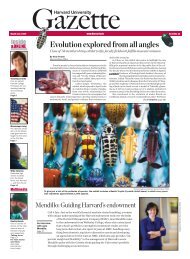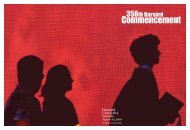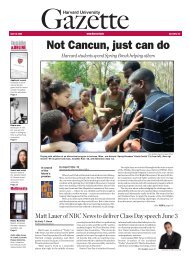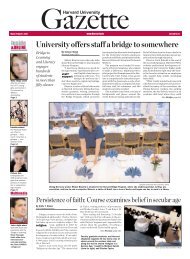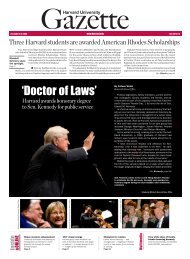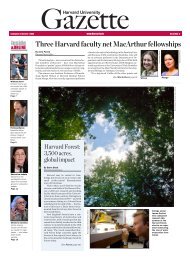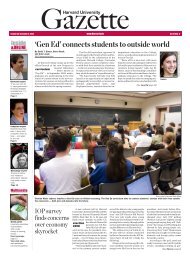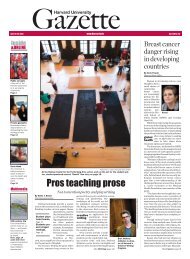Lawrence Lessig receives two Harvard appointments
Lawrence Lessig receives two Harvard appointments
Lawrence Lessig receives two Harvard appointments
- No tags were found...
You also want an ePaper? Increase the reach of your titles
YUMPU automatically turns print PDFs into web optimized ePapers that Google loves.
December 18, 2008-February 4, 2009 <strong>Harvard</strong> University Gazette/ 3Moorcroft models provide detailedview of forest responses to climate variationNEWSMAKERSRockefeller Fellows chosenThe Michael C. Rockefeller Memorial Fellowshipsadministrative board has awardedfellowships to six graduating seniors for2009-10. Rockefeller Fellowships contribute$18,000 toward a year of purposeful postgraduateimmersion in a foreign culture for individualsat critical stages in their developmentwho feel a compelling need for new andbroadening experiences.The six recipients are Lauren Brants ’09of Kirkland House, for travel to Mexico;Wilmarie Cidre ’09 of Kirkland House, fortravel to Chile; Nicholas Rizzo ’09 of LowellHouse, for travel to India; Nora Sluzas ’09 ofEliot House, for travel to China; Brittan Smith’09 of Pforzheimer House, for travel to SouthAfrica; and Cristiana Strava ’09 of EliotHouse, for travel to Morocco.Hedley-Whyte wins AAMI awardJohn Hedley-Whyte, the David S. SheridanProfessor of Anaesthesia and Respiratory Therapyat <strong>Harvard</strong> Medical School, has beenawarded the Association for the Advancementof Medical Instrumentation (AAMI) TechnicalCommittee Award for his role in the developmentof American National Standards and thecorresponding International Standards in theApplication of Risk Management to Medical Devices.These efforts are part of a White Houseinitiative on Medical Device Interoperability.Jon Chase/<strong>Harvard</strong> News OfficeProfessor of Organismic and Evolutionary Biology Paul Moorcroft: ‘The big question facing us is how are terrestrialecosystems responding to climate change and how will these responses feed back onto climate.’Modeling the forest ... and the treesBy Alvin Powell<strong>Harvard</strong> News OfficeWhen building computer models of theecosystems that cover the earth’s surface,it is tempting to incorporate sweepinggeneralizations in your calculations.The difficulty, of course, is that there isno guarantee that nature generalizes inthe same way. All the interactions of individualplants and animals have their ownsets of causes and effects.Accurately capturing the aggregate responseof an ecosystem or an animal populationthat arises from all those causesfacultyprofileand effects is critical if computermodels are to be effectivecrystal balls for predictinghow ecosystems respondto climate change, or how an animal populationwill respond to changes in its landscape.Paul Moorcroft, professor of organismicand evolutionary biology, isusing tools borrowed from statisticalphysics to create models that will increaseour ability to evaluate different courses ofaction in environmental management andglobal warming.“He had this beautiful insight that weshould look at a forest from the level of individualtrees,” said Steven Wofsy, Abbott<strong>Lawrence</strong> Rotch Professor of Atmosphericand Environmental Science and collaboratorwith Moorcroft. “He could look atsystems and take apart systems at a levelnobody else could.”Moorcroft borrowed concepts thatphysicists use in modeling fluids andgases, where the properties and behaviorsof individual particles are used to predictthe dynamics and flow patterns of the fluidor gas. His models treat the individualplants within an ecosystem as a physicis<strong>two</strong>uld “particles,” taking into account thatthose individuals respond to the environmentalconditions they experience, interactand affect each other’s behavior, andgovern the aggregate response of the system.“The big question facing us is how areterrestrial ecosystems responding to climatechange and how will these responsesfeed back onto climate,” Moorcroft said.Because ecosystems are so large, thestandard approach to designing ecosystemcomputer models has been to aggregatelarge tracts into a single generalizationof their behavior. The scale of a gridcell in a climate computer model is 1 degreelatitude by 1 degree longitude or larger,or more than 4,000 square miles.“It has generally been assumed that theecosystem within each grid cell will behavelike a single giant plant. That’s problematic,because we know that ecosystemsare much more complex and that the trueensemble of plants is likely to behave quitedifferently,” Moorcroft said.The problem with this so-called“ecosystem as big leaf” modeling approachis, of course, that 4,000-plussquare miles of forest doesn’t just hold onekind of plant. Rainforests in particularhold a dazzling array of tree and plantspecies, each of which will respond differentlyto changing conditions. Those differencesare particularly important whena forest is stressed, Moorcroft said, becauseit can affect a tree’s ability to survivefollowing the change in environmentalconditions.That could mean that, even if all individualsof a particular tree species do infact die off from hotter days and lowerrainfall, other species of tree are likely tosurvive, or even thrive. When building acomputer model of how global warmingmight impact the Amazon forest basin,capturing this reality can mean the differencebetween predicting a changing butpersisting forest and one that will die outentirely, to be replaced by grasslands.“In real ecosystems, there are differenttypes of plants in different places that behavedifferently. This heterogeneity canbe important when an ecosystem isstressed in response to climate change,”Moorcroft said. “We have been able toshow that capturing this heterogeneityleads to more accurate predictions of theecosystem’s behavior.”Moorcroft remembers always being interestedin both biology and mathematics.As an undergraduate at Cambridge University,he studied natural sciences, especiallyecology, and math. Moorcroft’s interestin predicting how the terrestrialbiosphere will respond to climate changegrew into his doctoral thesis research atPrinceton on predicting how the spatialpattern of animals on landscapes is governedby the movements of individuals.While he was at school in the 1990s,Moorcroft said there was a movement inecology to understand how individual dynamicscollectively determine the behaviorof populations, communities, andecosystems. Coupled with that was theemphasis at Princeton of employingmathematical models to address ecologicalquestions.Moorcroft joined field biologists collectingradio tracking data on coyotes inYellowstone National Park in advance ofthe wolf reintroduction. He searched theliterature to see how the populations hadbeen analyzed in the past and was surprisedto see that the work to date was(See Moorcroft, next page)Goldman invited to speak toHomeland Security CouncilJulian M. Goldman, a <strong>Harvard</strong> MedicalSchool instructor in anesthesia at MassachusettsGeneral Hospital (MGH), has recentlygiven an invited presentation to the WhiteHouse Homeland Security Council on medicaldevice interoperability requirements and technologiesthat improve patient treatment andsafety. Before coming to MGH, Goldman wasthe vice president of medical affairs for amedical monitoring company and a chair ofthe U.S. national standards committee foranesthetic and respiratory equipment.Steinkeller <strong>receives</strong> Humboldt AwardPiotr Steinkeller, professor of Assyriology in<strong>Harvard</strong>’s Faculty of Arts and Sciences, has receivedthe Humboldt Research Award from Germany’sAlexander von Humboldt Foundation.The award provides funding for internationallyrenowned scientists and scholars to pursue researchin Germany. From May 2009 throughJanuary 2010, Steinkeller will research the politicaland economic organization of Babyloniaat the end of the third millennium BCE, at theLudwig-Maximilians Universität München. Hewill work in collaboration with Walther Sallaberger,a professor of Assyriology at the university’sInstitut für Assyriologie und Hethitologie.Steinkeller, who has taught at <strong>Harvard</strong> since1981, has published three books and writtenmore than 100 scholarly articles and book reviews.His work focuses primarily onMesopotamia, and Steinkeller has led a rangeof courses on the history of ancientMesopotamia, Mesopotamian culture and religion,as well as the Sumerian and Akkadianlanguages.Counter at Nobel Prize ceremonyS. Allen Counter, director of the <strong>Harvard</strong>Foundation, attended the 2008 Nobel PrizeCeremony in Stockholm, Sweden, on Dec. 10.Counter was invited to the ceremony by theNobel Foundation and the Karolinska NobelInstitute, where he received his doctor ofmedical science degree in 1989. At theevent, Counter was able to meet with LucMontagnier, the winner of the 2008 NobelPrize in Medicine and Physiology for his discoveryof the HIV/AIDS virus.Compiled by Gervis A. Menzies Jr.


